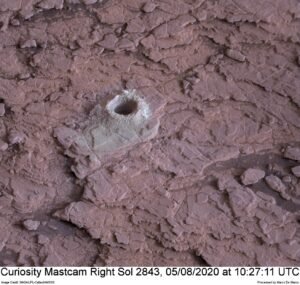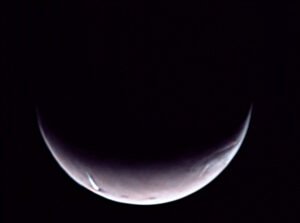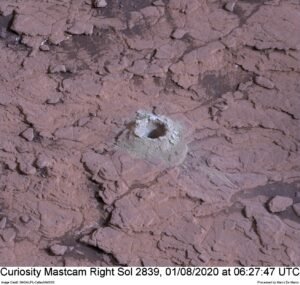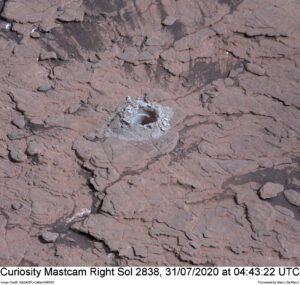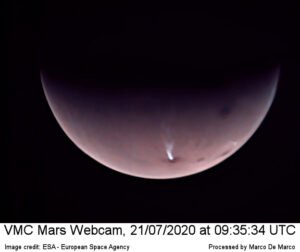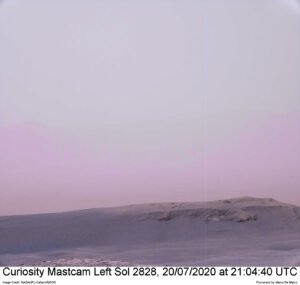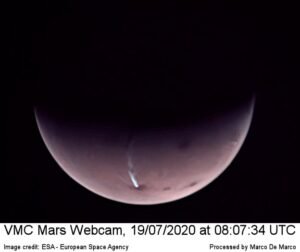Latest Posts
Curiosity Sol 2843, August 5, 2020
At 10:27:11 UTC the Mastcam Right has taken again the excavation called “Mary Anning” (see https://www.facebook.com/PianetaMarte.MdM/posts/3139037619512743 and https://www.facebook.com/PianetaMarte.MdM/posts/3134289306654241). From the comparison with the previous image, taken four days earlier, and despite the Sun is visibly lower, there are no particular color differences. On the other hand, you can see that some of the excavated material seems to have been blown by the wind towards the lower left corner of the image, with a direction rotated about 90° clockwise compared to four days ago.I want to emphasize that both this and the previous images were taken with the same camera and underwent the exact same processing with the exact same parameters!The original image is a black and white encoding of the Bayer mask that has been converted to color through a process called “debayering” or “demosaicing”. In addition, the photo has undergone a reduction of noise due to Jpeg compression, white balance and a slight increase in microcontrast and color saturation in order to make the colors more similar to what the human eye would see.Original image:https://mars.nasa.gov/msl-raw-images/msss/02843/mcam/2843MR0148730000505009C00_DXXX.jpg This post has been automatically translated. See the original post here.
Arsia Mons, “the plume” continues to…
VMC Mars Webcam, August 3, 2020 At 17:29:16 UTC the VMC Mars Webcam on board the Mars Express probe, took this photo of Mars from an altitude of 10502.06 km.In this photo, the plume appears very dense and regular, as in the photo taken on July 17 (see https://www.facebook.com/PianetaMarte.MdM/posts/3090001407749698). To date, the only official ESA release is from last July 29 (see https://www.facebook.com/PianetaMarte.MdM/posts/3124313930985112). The original image has undergone a noise reduction, white balance and a slight increase of microcontrast in order to make the colors more similar to what the human eye would see. Original image:https://www.flickr.com/photos/esa_marswebcam/50186863526/ This post has been automatically translated. See the original post here.
Curiosity Sol 2839, August 1, 2020
At 06:27:47 UTC the Mastcam Right took another picture of the excavation called “Mary Anning” (see https://www.facebook.com/PianetaMarte.MdM/posts/3134289306654241). A comparison with the previous image, taken only one day earlier, already shows some interesting differences. The surrounding rocks appear a more saturated red and some of the excavated material appears to have been blown by the wind towards the lower right corner of the image. Curiously, some of the sand present between the rocks has moved in the totally opposite direction. This apparent contradiction could find an explanation in the vibrations induced by the internal activities of the rover, vibrations that could cause settling of the sand, moving it also in the opposite direction to the prevailing direction of the wind.I want to emphasize that both this and the previous image have been taken with the same camera, in very similar lighting conditions and have undergone the exact same processing with the same parameters!The original image is a black and white encoding of the Bayer mask that has been converted to color through a process called “debayering” or “demosaicing”. In addition, the photo has undergone a reduction of noise due to Jpeg compression, white balance and a slight increase in microcontrast and color saturation in order to make the colors more similar to what the human eye would see. Original image: https://mars.nasa.gov/msl-raw-images/msss/02839/mcam/2839MR0148560000704791C00_DXXX.jpg This post has been automatically translated. See the original post here.
Curiosity Sol 2838, July 31, 2020
At 04:43:22 UTC the Mastcam Right has resumed the new excavation in the rock made by the Curiosity driller.This drilling, called “Mary Anning”, is as always 1.6 cm wide and shows us the true color of the rock apart from the reddish layer that covers it.Part of the excavated material will be analyzed inside the rover, expanding the mineralogical information collected in the Gale crater.In this case, the excavated material appears to be a very faded pink, although the inner part of the excavation shows faint shades towards blue. It will be very interesting to observe its evolution over time, as we have already done for other excavations, considering this as a reference image for later comparisons.The original image has undergone a reduction in noise due to Jpeg compression, white balance and a slight increase in microcontrast and chromatic saturation in order to make the colors more similar to what the human eye would see. Original image: https://mars.nasa.gov/msl-raw-images/msss/02838/mcam/2838MR0148440010704747E01_DXXX.jpg This post has been automatically translated. See the original post here.
Perseverance, the search for life on Mars resumes!
Your browser does not support HTML video. Evening of study in the company of Prof. Giorgio Bianciardi (Astrobiologist), Dr. Tiberio Cuppone (Geologist) and Prof. Roberto Orosei (Astrophysicist). With the collaboration of the Observatory N. Copernicus of Saludecio (RN). Direction and Technical realization by Mattia Peiretti. This post has been automatically translated. See the original post here.
Post from July 29, 2020
First ESA release… This post has been automatically translated. See the original post here.
Perseverance, the search for life on Mars resumes!
A scientifically hot evening!Will you be attending as well? This post has been automatically translated. See the original post here.
Arsia Mons, “the plume” shows interesting evolutions…
VMC Mars Webcam, July 21, 2020 At 09:35:34 UTC the VMC Mars Webcam on board the Mars Express probe, has taken this photo of Mars from an altitude of 9260.96 km.In this photo, the plume appears very dense and regular only in the first section, then seems to suddenly fade away, although it still continues for a long stretch.The original image has undergone noise reduction, white balance, and a slight increase in microcontrast in order to make the colors more similar to what the human eye would see. Original image: https://www.flickr.com/photos/esa_marswebcam/50139618151/ This post has been automatically translated. See the original post here.
Curiosity Sol 2828, July 20, 2020
At 21:04:40 UTC Mastcam Left captured the inner rim of Gale crater, almost completely obscured by haze.To realize the extent of the obfuscation, I recommend comparing it with the image taken on December 11, 2019 (see https://www.facebook.com/PianetaMarte.MdM/posts/2591188424297668). The sky looks decidedly milky and the crater rim is barely distinguishable. Don’t be surprised if the reddish parts of the hills in the distance are also the easiest to make out; even on Earth cars use orange headlights to see through the fog, precisely because light with a longer wavelength passes through the fog better than light with shorter wavelengths (blue light).Note well that the sky does not tend to red, a clear indication that this is real haze (from water vapor) and not suspended dust!The original image is a black and white encoding of the Bayer mask that has been converted to color through a process called “debayering” or “demosaicing”. In addition, the photo has undergone noise reduction due to Jpeg compression, white balance and a slight increase in microcontrast and color saturation in order to make the colors more similar to what the human eye would see. Original image: https://mars.nasa.gov/msl-raw-images/msss/02828/mcam/2828ML0148040000208720C00_DXXX.jpg This post has been automatically translated. See the original post here.
Arsia Mons, “the plume” gets longer!
VMC Mars Webcam, July 19, 2020 At 08:07:34 UTC the VMC Mars Webcam on board the Mars Express probe, has taken this picture of Mars from a height of 10177.24 km.In about two days the length seems more than doubled, I have a strong feeling that this time we will see good things!For those who want to deepen implications and background of the phenomenon, I strongly recommend watching the video I made in November 2018 in which I illustrate why it can not be an orographic cloud (see https://www.youtube.com/watch?v=eO7zC9-WBN4). The original image has undergone noise reduction, white balance, and a slight increase in microcontrast in order to make the colors more similar to what the human eye would see. Original image: https://www.flickr.com/photos/esa_marswebcam/50129141753/ This post has been automatically translated. See the original post here.
